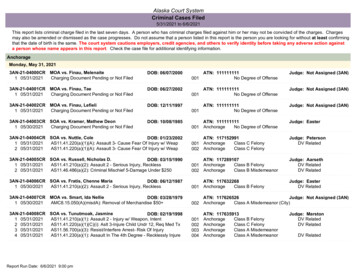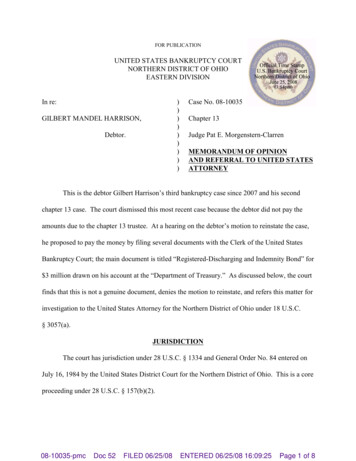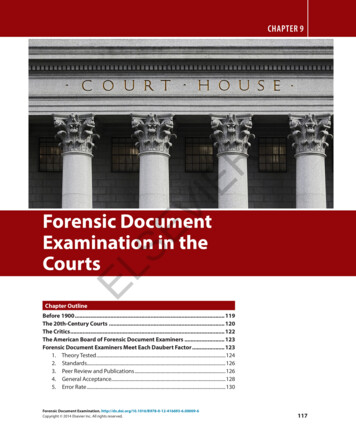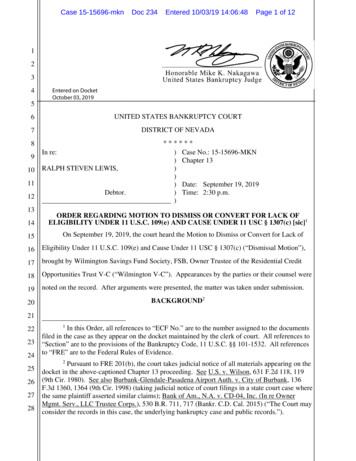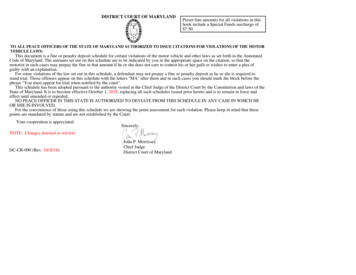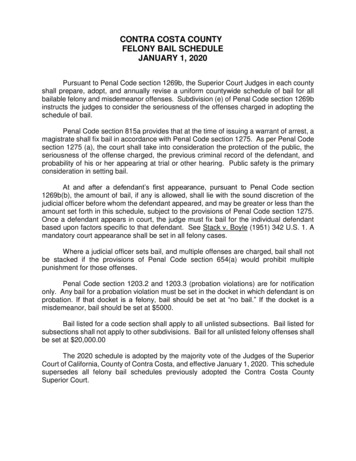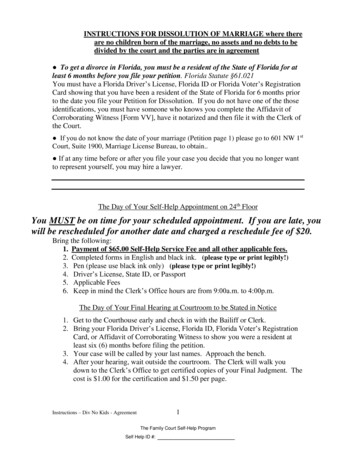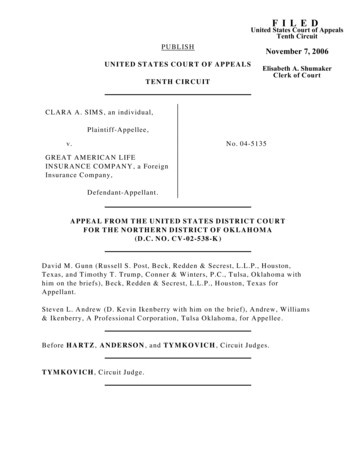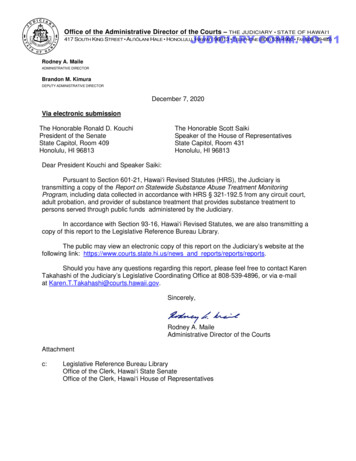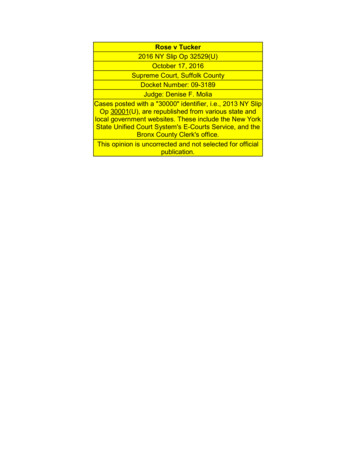
Transcription
The Future of Courts: The Next 10 YearsWhat is the Future of eTickets?The ScenarioIt has been over 15 years since electronic traffic citations (eTickets) were first introduced.i Within a fewyears one or more law enforcement agencies in over two dozen states were using systems toelectronically issue traffic citations. In 2003 infrastructure work began with the Global JusticeInformation Sharing Initiative standardizing data exchange formats for a number of functions includingtraffic citations. This evolved into work on the National Information Exchange Model (NIEM), whichpaved the wave for more standardized data transfer from law enforcement to the courts and statewidedatabases such as state departments of motor vehicles (DMV).iiExamples of actual eTicket conversions include the San Jose Police Department and the Indiana StatePolice in 2007;iii several Alabama law enforcement agencies, the State of Maryland, Florida’s Miami–Dade County, and Oklahoma City all by 2008;iv numerous municipalities in Cook County, Illinois by2011;v and the Seattle Police in 2014.vi Issuing eTickets is now commonplace.BenefitsThere are some obvious benefits of eTickets that help both law enforcement and the courts.vii Officers spend less time on the side of the road, which is one of the most dangerous spots for anofficer to be. Indiana State Police officers have cut their roadside stop time by a third,viii and SeattlePolice said officers have reduced the time it takes them to complete a collision report from threehours to 30 minutes.ixCourts dismiss fewer citations for transcription errors, illegible handwriting, or incorrectinformation (e.g. a violation written to have occurred at an intersection of two streets that do notactually intersect), mismatched ordinance or statute numbers, misspelled drivers’ names, orincorrectly written driver’s license numbers. For example, law enforcement officers in Indiana canswipe a driver’s license across their handheld device and accurately obtain the driver’s name, licensenumber, home address, height, weight, and hair color.xData can automatically upload to the court and (optionally) to a statewide database system (e.g.,DMV). Clerks save time and court data is more accurate since there is no more manual data entryinto the court’s case management system (CMS).xiTraffic violation and accident data can be instantly verified.Drivers can quickly be on their way; they could conceivably drive directly to the courthouse and pay–1–
their fine (if eligible). They might even be able to pay directly from their SmartPhones without evertravelling to the courthouse. This added convenience and efficiency was noted in the 2005 COSCAPosition Paper the Emergence of E-Everything.xiiThe eTicket trend has been sweeping the nation for a decade and half, so why haven’t paper trafficcitations gone the way of three by five index cards? Why are so many jurisdictions still buying thoseleather bound ticket books and officers still scrawling out paper citations?ChallengesFirst, converting to eTickets means local law enforcement, courts, and usually the DMV, must jointlycommit to a long–term coordinated objective, one that usually takes months and sometimes years toachieve. It requires finding money to purchase the new equipment; selecting a vendor; entering intocontracts; modifying and testing computer systems; training officers, staff, and judges; drafting newprocedures, policies, rules, and occasionally laws; and finally launching, reviewing, and refining a newtrans–agency operation.Second, economies of scale enjoyed by large volume departments are often not realized by smalleragencies, many of which may be hard pressed to recover costs within the standard three to five yearreturn on investment (ROI) break point. Typical examples of agencies with low ticket volumes mightinclude transit police issuing bus riding tickets, local college police issuing tickets to students, animalcontrol issuing barking dog tickets, and local code enforcement agencies issuing tickets for violationssuch as standing water, improper recycling, or construction site litter.A recent analysis revealed that nearly six in ten courts in the United States are one or two judge courts.xiiiSmaller courts may also be challenged to see a reasonable cost recovery period.Third, even when there is no outright animosity between different government organizations, relationsbetween the different branches (judicial and executive) and between different levels (local, county, andstate) can seem independent and indifferent to an enterprise that needs a united front in order tosucceed. Frequently, law enforcement agencies apply for substantial grants in order to get over theconversion “hump.” A single handheld device, for example, could range from 1,000 to 4,500.xivAnnual software license renewals and upgrades can run into the thousands of dollars. Though manynewer court computer systems come with the capability to accept eTickets built in, this software featureis by no means universal. If a court needs modifications to its CMS, those costs may not even enterinto the overall financial equation. If all stakeholders are not advocating for generally the same goal, thechances for funding success decrease.Fourth, to enjoy optimal efficiency, courts need to employ automated payment systems so violators canpay electronically by credit or debit card without ever coming to the courthouse. Many courts do nothave automated payment systems, and others believe that physically travelling to the downtowncourthouse to pay a traffic fine is part of the retributive, therapeutic, deterrence process.Various law enforcement agencies need to run their operations as they see fit. Yet, if some agenciesremain attached to paper tickets, courts may be saddled with multiple parallel ticket processing methods,which require more staff. Differing operations must be managed, differing policies and rules must beremembered and applied, differing payment procedures must be used, and basically differing tickethandling methods confuse the public.–2–
The ScenarioIt is Monday morning, January 5, 2026. Once again, Jess reluctantly prepares to battle the county overher latest funding request for yet another court computer modification. Jess is the court administratorfor the Outland County Justice Court, which receives citations from a variety of law enforcementagencies. The Court gets half of its tickets from the Canyon City Police (Outland County’s main city);20 percent come from the Outland County Sheriff’s Office, which patrols unincorporated areas; another20 percent comes from the Centreville Police, a village 40 miles from Canyon City; and ten percentcome from County Animal Control for violations like barking dogs.Following national trends, the Canyon City Police converted to eTickets five years ago. Both the policeand the court enjoyed cost reductions from more efficient operations. Canyon City Police eTickets areelectronically transmitted to the Court overnight allowing drivers to pay their fines the next business dayusing the court’s ePayment system. Courthouse foot traffic has dropped off significantly and court staffno longer have to manually enter traffic citation data into the court’s CMS. Dismissals due to illegiblehandwriting or incorrect ticket information have declined; and drivers with suspended licenses are nowinstantly identified from the state DMV database.The down side? Jess went to the county five years ago requesting funding to modify the court’s CMS inorder to accept, process, display, and dispose of electronic citations. Courtdyne Industries has been thecourt’s vendor for quite a while and their price tag for the modification was not cheap. The countydemanded demonstrable cost reductions in return for their 40,000 “one–time–only” allocation.Jess was able to show real cost savings after the first round of funding, but she is skeptical she will findenough savings this time to match the 25,000 she needs to complete the conversion. The CountySheriff and Animal Control both have “homegrown” computer systems, which are incompatible withthe court’s CMS; Centreville police still write their citations by hand and mail them to the court twice aweek. The court is forced to maintain both an electronic and a manual citation processing system.Operating dual systems wastes staff time, is confusing, slows workflow, and confuses the public. Noneof the three agencies write enough tickets to show a convincing cost recovery, yet combined they areannoying. Undaunted, Jess pushes through the swinging door to the budget meeting, PowerPoint flashdrive in hand, and prepares to make her pitch to the finance people.Court Professionals Say This Scenario is LikelyThe Winter 2016 Future of Courts surveyreceived 355 responses. Respondents assessedlaw enforcement agencies moving to eTickets inthe next ten years as Highly Likely. The overallaverage was 1.5 on the five point scale with 1being Highly Likely and 5 being Improbable.xv Thisassessment was basically reflected acrossjurisdictional levels with the general jurisdictioncourt respondents averaging 1.6 and limitedjurisdiction court respondents averaging 1.4. BabyBoomers, Millennials, and Generation Xers allassessed the scenario at 1.5.–3–
The RespondentsTo respond to the above scenario and the likelihood that eTickets will become the accepted method ofissuing traffic citations in the next ten years are Tim Leger, Judicial Administrator for Lake Charles CityCourt in Louisiana; Tim Guesman, Business Systems Analyst and Acting Department SystemsAdministrator for the Las Vegas Justice Court in Nevada; Angela Graddy, Court Administrator for theYuma Municipal Court in Arizona; David D. Beach, Director of Court Services for the Municipal Courtin Findlay, Ohio; Gerry Durfee, Court Administrator for the Municipal Court in the City of MarylandHeights, Missouri; Sharon Yates, Deputy Court Administrator for the Coconino Superior Court, inFlagstaff, Arizona; Cheryl Stone, Court Administrator for the Municipal Court in Eugene, Oregon; andAlbert De La Isla, Principal Administrative Analyst for Criminal Operations at the Orange CountySuperior Court in California.How Well Does the Scenario Predict the Future?Despite the optimistic assessment of the Future of the Courts survey results, many of our respondersthought it likely that we would still have handwritten tickets ten years from now. Tim Leger (LakeCharles, Louisiana) agreed that the scenario of courts receiving some paper tickets is highly likely.Changing operating system platforms, planned software obsolescence, and a lack of uniformity ofexisting networks will all play a part in this.Lake Charles City Court is a hybrid court. Eighty percent of the traffic and 40% of the criminal mattersoriginate from the Lake Charles Police Department (LCPD) and are handled by the City Prosecutor.Roughly 20% of traffic and 60% of criminal matters are handled by the District Attorney.Over eight years ago, LCPD bought their officers ten handheld eTicket writers. The intent of the initialproject was to eventually issue all citations by handheld eTicket writers. The City Court even pledgedmoney to buy the police more eTicket writers as needed. After six years, the project never got off theground and LCPD abandoned it. One of the main reasons was the cost of the software.Last year, the Louisiana Supreme Court gave the City Court a 10,000 grant to import citation data fromthe police database to the Court’s database. The grant was used to build a software interface for theLCPD’s AS400 mainframe and export the data to the Court’s SQL based server.Tim Guesman (Las Vegas), Angela Graddy (Arizona), Albert De La Isla (California), and Gerry Durfee(Missouri) all could see some tickets still being handwritten ten years from now. Angela and Timthought the eTicket/handwritten divide would be because of cost. Courts may have multiple lawenforcement agencies filing cases and there may need to be multiple integration points if each agency isusing different eTicket hardware and software. For example, one agency may use handheld writers,another agency may have the eTicket equipment installed in their patrol cars, yet another agency mayonly transmit data to the court from their CMS at the stationhouse. Multiple entry points mean multiplemethods of accepting data, which means more money needed for computer conversions.–4–
Tim and Albert both considered it likely their courts would still be receiving some handwritten ticketsfrom lower volume agencies where conversion costs would be prohibitive. Angela declared that unlessstate and local law enforcement agencies assist smaller courts, jurisdictions will still have paper ticketsand of course handwritten tickets would still need to be a back–up in case of a system outage.Gerry thought more serious tickets like DWI will still need to be handwritten because prosecutorsshould be able to see the citation as the issuing officer wrote it.On the other hand, David Beach (Ohio), Sharon Yates (Arizona), and Cheryl Stone (Oregon) all hopeto see courts receiving only eTickets within ten years. Cheryl and David both thought it was highlylikely that all citations will be eTickets within that time frame.Does Your Court Receive eTickets Now?Gerry, Cheryl, and Albert said their courts receive eTickets. Gerry said the Maryland Heights MunicipalCourt receives eTickets for non–moving violations but tickets for more serious offenses (e.g., DWI) arestill handwritten. Cheryl said Eugene Municipal Court receives electronic data from handwritten tickets;the court then matches the data with the submitted paper tickets.] Albert said Orange County SuperiorCourt has an interface with three different eTicket providers that support multiple police agencies, butthe Court still receives handwritten tickets from smaller agencies, direct filed misdemeanors (eTicketsthat are electronically filed are currently only for infractions), and from officers
databases such as state departments of motor vehicles . courts may be saddled with multiple parallel ticket processing methods, which require more staff. Differing operations must be managed, differing policies and rules must be remembered and applied, differing payment procedures must be used, and basically differing ticket handling methods confuse the public. –3– The Scenario It is .
